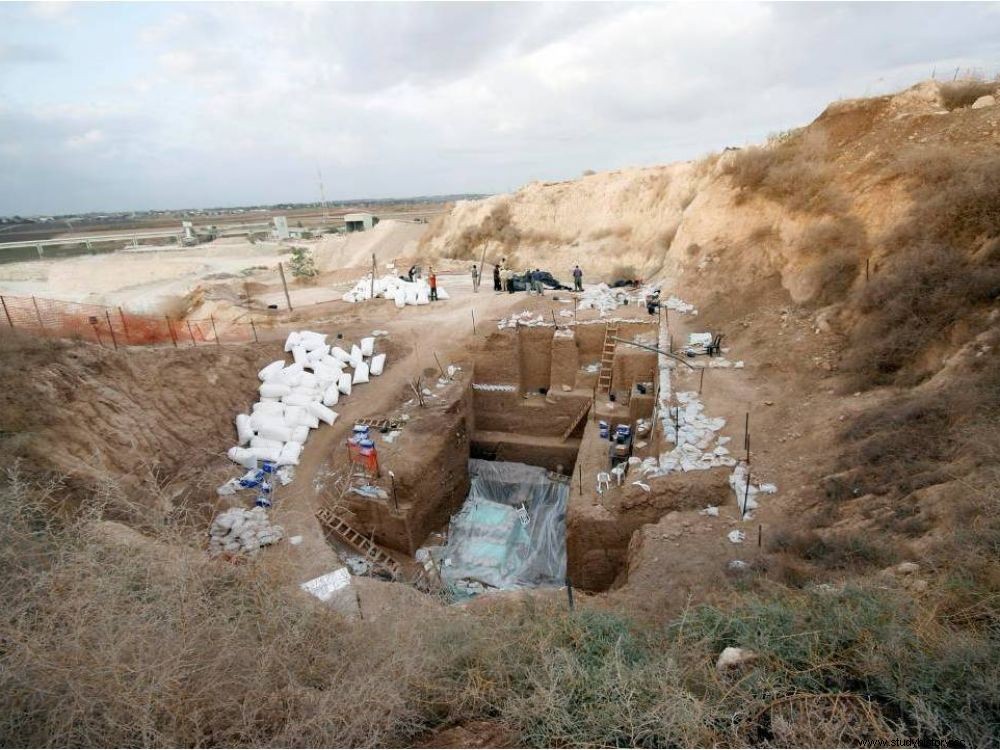The discovery and excavation of a site in Israel revealed the existence of cultural exchanges between populations.

The excavation of Nesher Ramla yielded thousands of carved flints, animal remains and the fossil of an Archaic Man.
The site of Nesher Ramla is located in central Israel, near the city of Ramla. It was discovered during public works in 2010 and a salvage excavation was organized there. She revealed, in this bowl-shaped basin, the presence of numerous animal remains, thousands of carved stones and the fossil of an archaic man who frequented it between 140,000 and 120,000 years ago. .
An unknown population at that time
“But the thousands of flint fragments and animal remains found at the site testify to a lasting human presence that spans a period ranging from 140,000 to 90,000 years. On the other hand, it is only in level 6, the deepest, that human bones have been discovered ” explains Marion Prévost, of the Hebrew University of Jerusalem. These bones, a portion of the cranial vault and a fragment of the mandible, have been virtually reconstructed in order to be compared with other fossils from Europe, Asia and Africa. The results indicate that they exhibit characteristics that set them apart from those of modern humans and Neanderthals who lived at the same time in Europe. For lsrael Hershkovitz and his colleagues who publish a first article in the journal Science , this skeleton belongs to one of the last representatives of a hitherto unknown local population of Archaic Man who developed in the Middle East during the Middle Pleistocene (between -781,000 and -126,000 years ago).
The site of Nesher Ramla is located in central Israel, near the city of Ramla. It was discovered during public works in 2010 and a salvage excavation was organized there. She revealed, in this bowl-shaped basin, the presence of numerous animal remains, thousands of carved stones and the fossil of an archaic man who frequented it between 140,000 and 120,000 years ago. .
An unknown population at that time
“But the thousands of flint fragments and animal remains found at the site testify to a lasting human presence that spans a period ranging from 140,000 to 90,000 years. On the other hand, it is only in level 6, the deepest, that human bones have been discovered ” explains Marion Prévost, of the Hebrew University of Jerusalem. These bones, a portion of the cranial vault and a fragment of the mandible, have been virtually reconstructed in order to be compared with other fossils from Europe, Asia and Africa. The results indicate that they exhibit characteristics that set them apart from those of modern humans and Neanderthals who lived at the same time in Europe. For lsrael Hershkovitz and his colleagues who publish a first article in the journal Science , this skeleton belongs to one of the last representatives of a hitherto unknown local population of Archaic Man who developed in the Middle East during the Middle Pleistocene (between -781,000 and -126,000 years ago).

The two bone fragments found correspond to a mandible and a piece of parietal bone. Credit:Tel Aviv University .
Older fossils with a combination of features seen in both Neanderthals and modern humans discovered in the region are also thought to be linked to this population. They testify to a complex evolutionary history of the humanities in this area located at the crossroads of three continents and where genetic exchanges between peoples and migrations were certainly numerous. This finding notably challenges the prevailing assumption that Neanderthals originated in Europe, suggesting that at least some of the Neanderthals' ancestors actually came from the Levant.
Reconstruction of a tooth from the Man of Nesher Ramla. Credit: Ariel Pokhojaev, Sackler Faculty of Medicine, Tel Aviv University .
Butchery and stone cutting
But let's get back to our Man of Nesher Ramla. It has therefore been discovered around a large number of cut stones which are very special “since they are produced with the same flints and the same cutting methods, those of centripetal Levallois, which are normally found on sites specific to Homo sapiens ” reveals Marion Prévost. This means that cultural exchanges took place between his people and tribes of sapiens whose trace is found between 50 and 100 km from Nesher Ramla, at the same period. “We can no longer say that a technology or a cutting method is associated with a particular group of humans since we observe that there have been interactions between them, at least in the Levant, with knowledge exchange ” emphasizes the archaeologist. A discovery that is the subject of a second article also published by the journal Science .

Nesher Ramla flint carved using the centripetal Levallois method. Credit: Tal Rogovsky .
These flints were used to cut meat. The site of Nesher Ramla is indeed not the place of a habitat but a site specialized in stone cutting and butchery. “Men sometimes had to stay there for several days, even weeks, but probably not permanently as in a residential site”, says Marion Prévost. On site, they processed meat from aurochs, wild ibex, gazelle, horse and other smaller mammals as well as turtles. Clues allow us to suppose that certain plants were also worked and hearths, bones and burnt flint, were brought to light indicating their mastery of fire. Some 80,000 lithic objects have been extirpated from Nesher Ramla, enough to occupy scientists for many years. We bet that they still have a few surprises in store for us...
